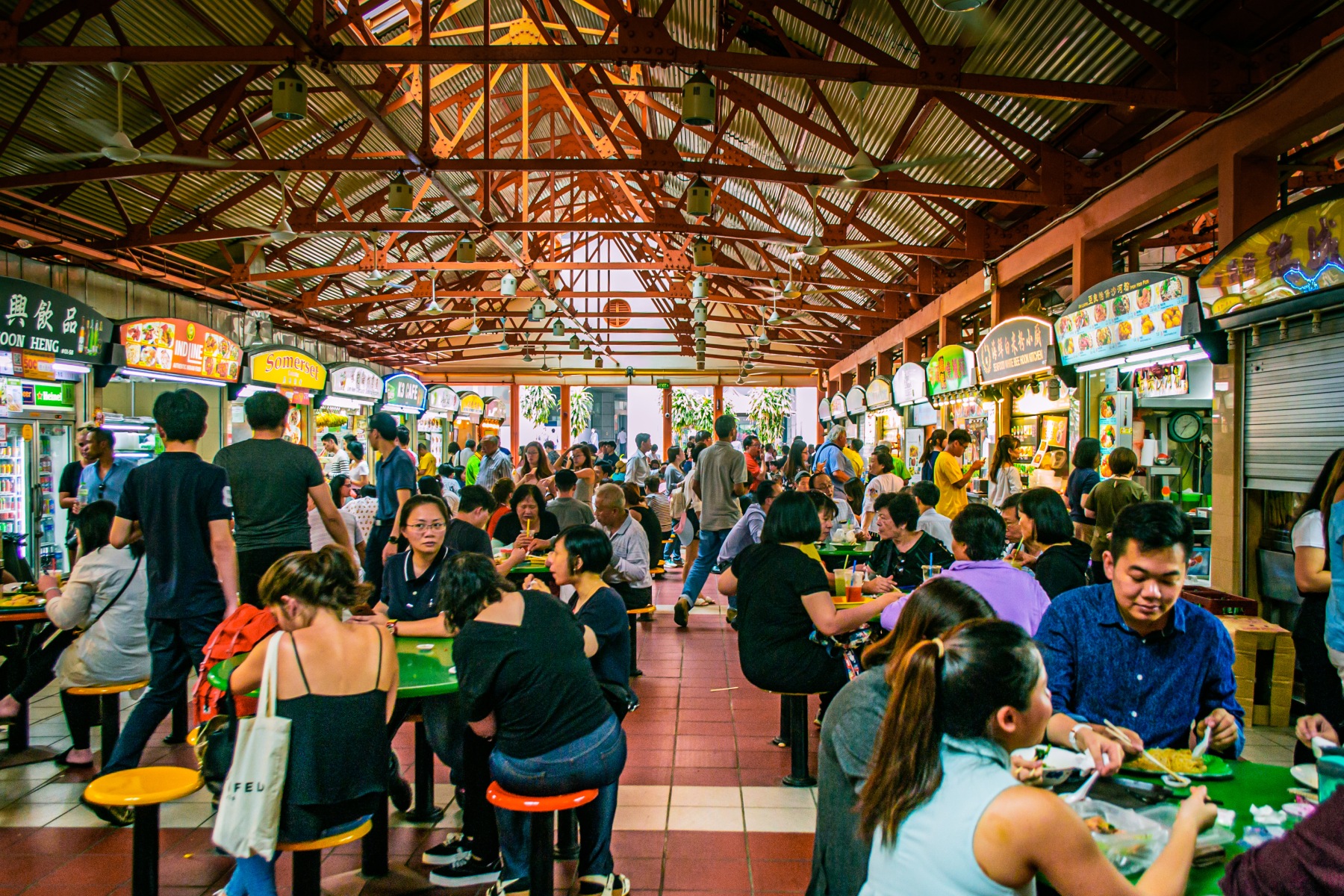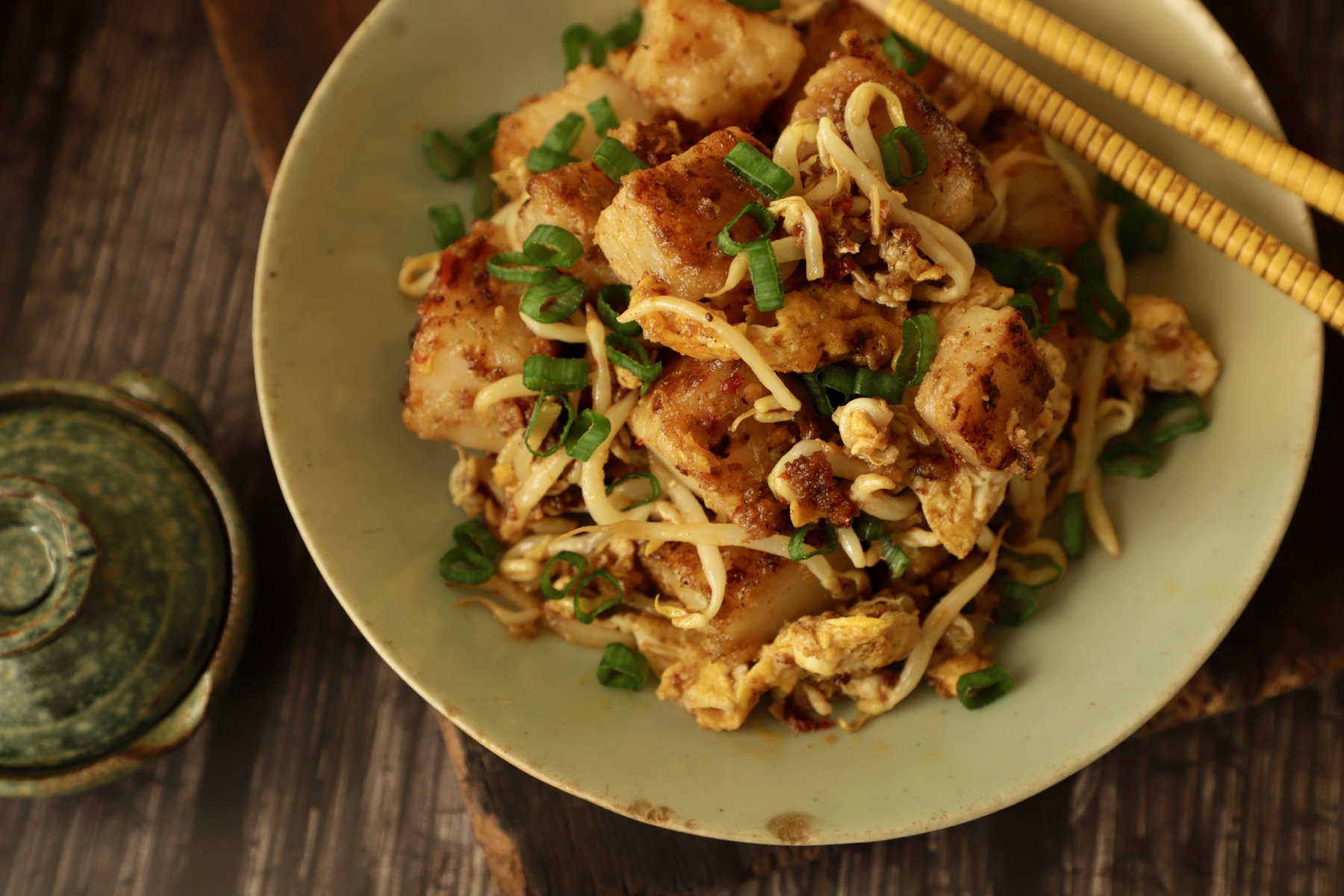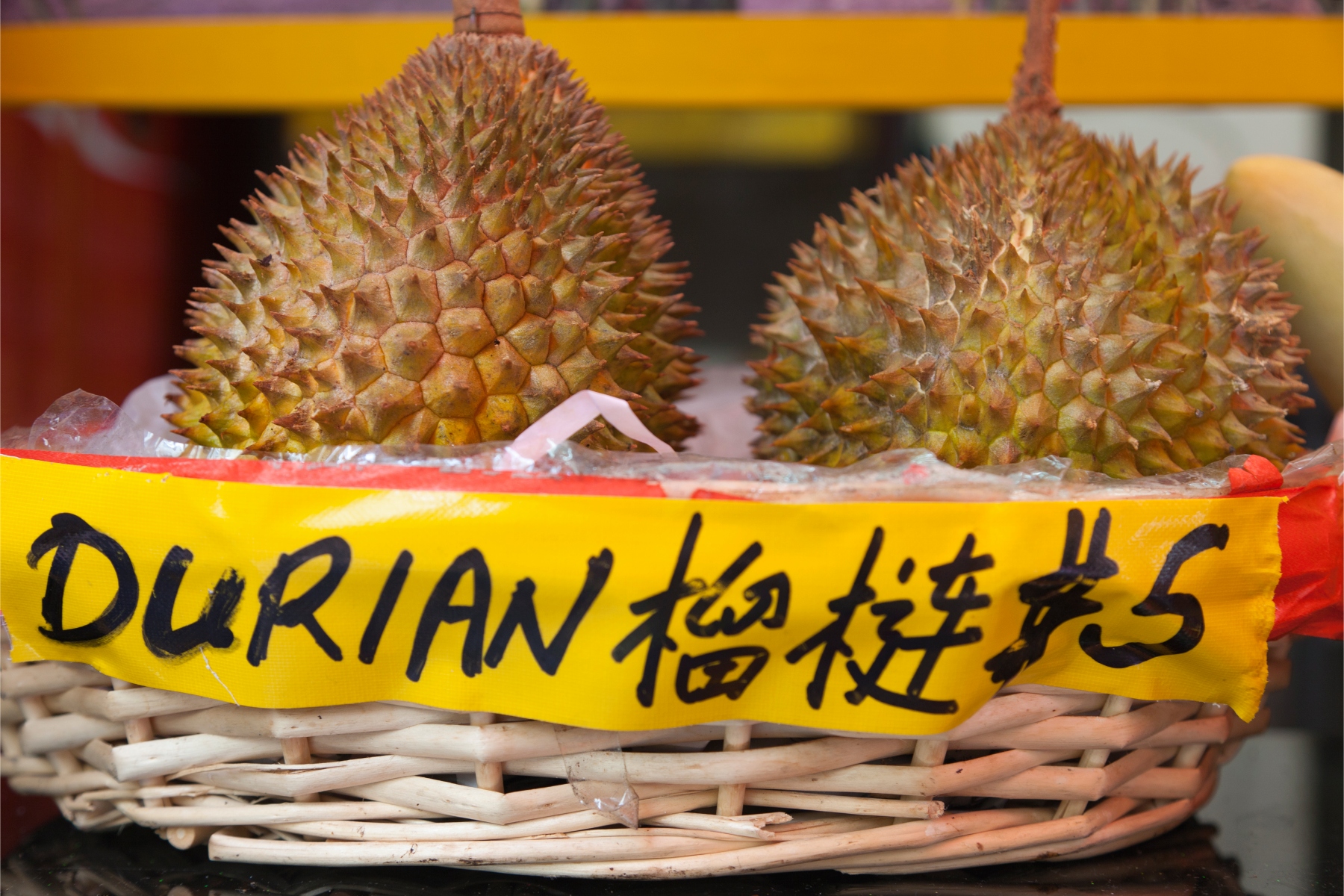Moving to a new country like Singapore involves many must-do tasks, from finding a home and organizing visas to navigating cultural nuances. But no matter how busy new arrivals are, they have to eat.
Luckily, there is no better way to get to know what makes a country – and its people – tick than figuring out their food habits.
Tuck into Singapore’s dynamic food scene with the following topics:
- An overview of Singaporean cuisine
- What is the Singaporean cuisine and diet like?
- Does Singaporean cuisine include any celebratory meals?
- What ingredients are used in Singaporean cuisine?
- What are the Singaporean cuisine’s most famous dishes?
- What desserts are well-known in Singaporean cuisine?
- Useful resources
An overview of Singaporean cuisine
Like the country itself, Singaporean cuisine is a rich, diverse landscape and has plenty to offer. Due to its history and geographic position, traditional food draws inspiration from a wealth of cultures, including Chinese, Indian, Malay, and Global North influences.

Two unique cultures have developed in Singapore, including particular types of cuisines:
- Eurasian cuisine: The result of Global North and Asian heritage, which has given way to a specific style of cooking
- Peranakan cuisine: Born from the Straits Chinese culture, this is a unique blend of Chinese and Malay heritage
In the mid-19th century, hawker centers began springing up around Singapore to offer delicious yet affordable food to the masses. These are open-air food halls with numerous stalls selling a wide variety of food, showcasing the full breadth of Singaporean cuisine.
Although the country offers plenty of delicious food – especially from hawker centers – it is not all healthy; 10% of Singaporeans have diabetes (2019).
Consequently, the Singaporean Health Ministry has set up the Healthier SG program, encouraging locals to adopt healthier lifestyles and diets.
What is the Singaporean cuisine and diet like?
Breakfast
Singaporean cuisine offers a wide variety of breakfast options. Expats, however, should not expect traditional Global North-style meals that include eggs or continental pastries. While these are widely available, the day’s first meal typically encapsulates Singapore’s diverse cultural heritage.
At the local diners (kopitiams), the top choice for breakfast is kaya toast, served with soft-boiled eggs – seasoned with pepper and dark soy sauce – and washed down with one of several varieties of coffee (kopi) or tea (the).
This popular local dish draws influences from the Hainan province in China, the United Kingdom (UK), Portugal, and Spain.

Kaya is a quintessential Singaporean condiment: a sweet, thick, custard-like spread made from pandan leaves. For kaya toast, the jam is thickly spread onto two slices of white bread, and a generous chunk of butter is placed in between to create a decadent breakfast sandwich.
Singaporean breakfast foods
Not in the mood for a sweet start? No problem. The country’s kopitiams offer plenty of other local breakfast dishes that will tantalize your tastebuds. Here are a few to take note of:
| Dish | Description |
| Chai Tow Kway (Carrot Cake) | Chinese Teochew-originated dish made of stir-fried radish cake |
| Chwee Kueh | Chinese Teochew-originated dish of steamed rice cakes with preserved radish |
| Congee | Chinese-style rice porridge, available in a variety of flavors |
| Lor Mee | Chinese Hokkien noodle dish with gravy base, fish and meat dumplings, and boiled egg |
| Mee Goreng | Flavorful fried noodles with a variety of seafood and tofu |
| Nasi Lemak | Aromatic rice with fried chicken or fish, steamed fishcakes, balachan (chili paste), and ikan bilis (small fried anchovies with peanuts) |
| Roti Prata | Southern Indian-style fried round flatbreads – available with or without egg – usually eaten with fish, chicken, or mutton curry |
Most Singaporeans eat breakfast before work or school, between 06:00 and 09:00. Despite the tempting options, most locals often eat a quick piece of toast or cereal during the week.
Lunch
Most Singaporeans have lunch between 12:00 and 14:00, conveniently breaking up their work or school day. Local office workers typically head to the nearest hawker center or diner to enjoy a casual meal away from the workplace.
As with breakfast, Singapore cuisine has a wide variety of dishes available for lunch. Again, these draw on the country’s many cultural influences so that you might enjoy Chinese, Indian, Malay, Indonesian, or Global North-style meals.
As with most meals in Singapore, carbs are the star of the show for lunch. As a result, you can expect rice, noodles, or bread to form the base of the meal. Some of the more popular lunch dishes in Singapore include:
| Dish | Description |
| Bak kut teh/Bah kuh te (BKT) | Hokkien-Chinese meat broth paired with various accompaniments |
| Biriyani | Indian rice dish with vegetables and meat |
| Hainanese chicken rice | Seasoned rice served with poached chicken, garnish, and chili sauce |
| Hokkien Mee | Wok-fried egg noodles with prawns, egg, and squid |
| Laksa | Spicy noodle soup with various toppings |
Although these dishes are readily available, it does not mean everyone eats them all the time. People often bring leftovers or homemade meals to the office or school for lunch or buy more simple meals like salads and sandwiches.
Dinner
A Singaporean dinner is typically between 18:00 and 22:00 and is quite similar to lunch in that it is carb-heavy. If having dinner at a hawker center, patrons will often enjoy many of the same dishes as at lunchtime.
Usually, locals enjoy dinner at home during the week, even if they get takeout from their nearest hawker center. Alternatively, families will often cook dishes from their particular culinary traditions.
For example, an Indian family might make rice and some type of curry and cooked vegetables, while a Chinese family might make a stir-fried noodle dish or rice with stewed meat or fish and vegetables.
Which snacks are part of Singaporean cuisine?
Eating is practically a national sport in the country, and because of this, Singaporean cuisine features a wide variety of snacks. Like all other food, snacks here originate from several different cultures.

Global North-style cakes and pastries are popular, as well as baked goods infused with regional flavors.

Writer and local expert
Gayatri Bhaumik
Insider tip
Local chain Old Chang Keeu whips up decadent delights like curry puffs, fried chicken wings, chicken nuggets, cuttlefish balls, and the like – all wildly popular with locals.
Another popular franchise, Bee Cheng Hiang creates all sorts of jerky-style barbecue meats in different flavors that make a delicious sweet-yet-savory snack.
If you plan to sit down at a local restaurant or hawker center, you will have access to all sorts of heftier snacks, such as:
| Snack | Description |
| Bakkwa/rougan | Barbecued meat, similar to jerky |
| Popiah | Chinese-style fresh-filled spring rolls |
| Rojak | Fruit salad served in a spicy palm sugar dressing |
| Samosa | Indian pastry with savory fillings |
| Satay | Skewered grilled meats |
Does Singaporean cuisine include any celebratory meals?
Lunar New Year
Early in the year (usually January or February), Singapore celebrates the Lunar New Year. Like most public holidays and national celebrations, food is the main attraction, and revelers gather throughout the day to savor special dishes.
Extended families usually enjoy these meals between them, though friends are frequently also invited. Expect to see some of the following dishes:
| Food | Description |
| Bakkwa | Beef or pork jerky is a popular gift because its deep red color symbolizes luck |
| Fish | On the eve of the Lunar New Year, families will traditionally serve a whole fish, then save half for New Year’s Day |
| Kue Bangkit | Tapioca cookies made in the traditional Nonya (Peranakan) style |
| Kue Kapit (Love Letters) | Decadent, crispy, sweet roll-ups made from eggs, sugar, coconut milk, and flour |
| Lo Hei (Prosperity Toss) | Teochew Chinese-style raw fish salad. Includes fish, shredded vegetables, and sauces. Traditionally, the food is tossed together while reciting wishes for prosperity. |
| Ong Lai (Pineapple tarts) | These delicious morsels are popular gifts. Ong lei translates into English as “prosperity has arrived.” |
| Pén Cài/Poon Choi | A traditional Cantonese Chinese dish filled with luxury ingredients like abalone, sea cucumber, and fish maw – usually served in a clay pot |
| Tangerines or mandarins | Popular gifts during the Lunar New Year as they symbolize luck |
Hari Raya Aidilfitri/Puasa
Most Islamic countries call this holiday Eid al-Fitr, but in Singapore, Hari Raya is the celebration that marks the end of Ramadan. This is also a significant festival that brings family and friends together. Some of the most popular Hari Raya dishes include:
| Dish | Coconut-milk-based stew, often made with slow-cooked beef and eaten with rice |
| Bubur Lambuk | Rice porridge filled with different ingredients, including sweet potato, prawns, and beef |
| Ketupat | Diamond-shaped rice cake packed in hand-woven coconut leaves |
| Kueh/Kuih | A variety of traditional sweets |
| Lemang | Glutinous rice and coconut milk grilled in bamboo stalks |
| Rendang | Coconut-milk based stew, often made with slow-cooked beef and eaten with rice |
| Satay | Skewered grilled meats |
| Sayur Lodeh | Rich, creamy, spicy coconut gravy featuring vegetables and tofu and served with ketupat |
Deepavali/Diwali
Singapore celebrates the Hindu Festival of Lights (Deepavali) in October or November. Of course, this means plenty of family gatherings and food.
However, dishes may differ depending on the family’s cultural roots. For example, northern Indian households may prepare different traditional foods than those from the south.

Here are a few dishes from Singaporean cuisine that you may find at a local Diwali celebration:
| Dish | Description |
| Arachuvitta Sambar | Lentil curry with coconut and spices |
| Chirote | Flight, flaky sweet pastry |
| Pakoras | Battered, fried snacks made with potato, onion, or paneer (a type of cheese) |
| Potato Varuval | Dry, spicy potato dish |
| Traditional Indian sweets (mithai) | Various delicacies such as ladoo, jalebi, barfi, rasmalai, payasam, and halwa/halva |
| Vadai | Savoury donuts made from lentils |
What ingredients are used in Singaporean cuisine?
Meats
Singaporean cuisine includes a fair amount of meat, though there is a clear preference for poultry. Residents consume around 36kgs of chicken per person yearly, or 214,400kgs per year (PDF).
Pork is also very popular in Singapore, with locals eating 22kgs per person every year. Conversely, while beef is widely available everywhere, consumption only amounts to some 4kgs per person annually.
Since Singapore does not have a large agricultural industry, most of the country’s meat comes from overseas, mainly from Brazil (45%). However, a good percentage comes from Malaysia (20%) and Australia (10%).
Singaporean cuisine includes meat in dishes such as:
- Bak kut teh
- Beef Rendang
- Char siu
- Hainanese chicken rice
- Roasted duck rice
- Satay
- Teochow braised goose
Fish
Seafood dishes are just as popular as meat plates in Singaporean cuisine, resulting in the country consuming a hefty amount of fish, around 133,400 tons each year.

While some local fish is available, more is needed to meet local demand. Therefore, most seafood is imported from Malaysia (25%), Indonesia (17%), and Vietnam (15%).
Among the country’s most popular types of fish are:
- Red snapper
- Mackerel
- Snakehead
- Grouper
- Barramundi
- Salmon
- Threadfin
- Seabass
- Pomfret
As for seafood at large, crabs, stingrays, prawns, octopus, and cuttlefish are also widely consumed.
Popular seafood dishes in Singaporean cuisine include:
- Barbecued stingray
- Chili crabs
- Fish head curry
- Oyster omelet
Vegetables
For vegetables in Singaporean cuisine, forget about greens like broccoli, carrots, and potatoes. While these are widely available in the country, they are uncommon in local dishes.
Instead, expect to find a variety of Asian vegetables, such as:
- Bok choy (Chinese cabbage)
- Choy sum (flowering cabbage)
- Gai choy (mustard leaf)
- Kailan (leafy, thick-stemmed green)
- Kang kong (water spinach)
- Spinach
Most vegetables in Singapore come from Malaysia (42%), though the country also imports from China (27%) and Australia (5%). In total, Singaporeans consume around 568 million kilos of vegetables a year.
Fruit
One of the best parts of living in Singapore is having access to an incredible selection of fresh tropical fruit. You can find common produce like grapes, bananas, oranges, and apples at all grocery shops and food markets in the country.
Additionally, however, Singapore offers more exotic fruits, including:
- Custard apple
- Dragon fruit
- Guava
- Jackfruit
- Lychee
- Papaya
- Rambutan
- Watermelon

Writer and local expert
Gayatri Bhaumik
Insider tip
You will want to brace yourself for one of Singapore’s most popular fruits. The large, spiky durian bears soft, white fruit, which is custard-like and rubbery. However, it gives off an eye-watering, pungent odor. It is an acquired taste, but locals love it and incorporate it into desserts and pastries.
Singaporeans eat plenty of fruit as part of their five-a-day, some 443,100 tonnes a year. The country imports most of its fruits, with the majority coming from Malaysia (40%), followed by China (13%), and South Africa (8%).

Carbohydrates
Carbohydrates are central to Singaporean cuisine, given that most meals have a foundation of rice, noodles, or bread. You can find carbs in plenty of dishes, including:
- Carrot Cake
- Hainanese chicken rice
- Mee Goreng
- Nasi Lemak
- Nasi Goreng
Cheese/dairy products
Milk is the country’s most popular dairy product, but not because it is in many dishes. Singaporeans frequently drink it, either plain or in the many local coffees and teas popular in the country.
While you can find other dairy products like cheese and yogurt anywhere, locals do not eat them like you would in Europe. Instead, you might find paneer (a type of Indian cheese) in local Indian-style dishes or yogurt used to make raita (a cold Indian condiment used to dull the spice heat).
Herbs and spices
Singaporean cuisine uses herbs and spices from across Asia, giving dishes unique flavors.
Popular herbs in Singapore include:
- Coriander
- Chinese chives
- Curry leaves
- Galangal
- Kaffir lime and leaves
- Laksa leaves
- Lemongrass
- Pandan leaves
- Spring onions
- Turmeric
Spices in the local cuisine consist of well-known Asian seasonings, including:
- Cardamon
- Cinnamon
- Chili
- Cloves
- Cumin
- Fennel
- Kampot pepper
- Star anise
Sauces and condiments
Of course, you will find ketchup, mustard, Worcestershire sauce, or other condiments in Singapore. However, expats would miss out if they don’t sample the delightful collection of local sauces to complement their dishes and, in doing so, open their tastebuds to many new flavor possibilities.
Perhaps you’re already familiar with soy sauce, Chinese-style chili sauces, sesame oil, and oyster sauce. But get ready to try:
- Balacan (shrimp paste) with Nasi Lemak
- Dark soy sauce (sometimes called black sauce) with Hainanese chicken rice
- Ikan bilis (small fried anchovies with peanuts) with Nasi Lemak
- Sambal hijau/cabe ijo with Nasi Campur and Nasi Padang
What are the Singaporean cuisine’s most famous dishes?
Want to know what to order at the local hawker centers? Here are some of the most popular Singaporean food to seek out:
- Bak kut teh
- Carrot cake
- Chili crabs
- Hainanese chicken rice
- Kaya Toast
- Laksa
- Mee Goreng
- Nasi Lemak
- Rojak
What desserts are well-known in Singaporean cuisine?
Have you got a sweet tooth? Then, you are in luck. Singaporean cuisine has plenty of desserts to fulfill your sugary cravings.

Here are some of the most popular desserts to try:
- Cendol: Ice cream laced with palm-sugar syrup with lashings of pandan jelly, red beans, corn, and – by request – durian
- Ice cream sandwiches: Sold in street cars, this dessert consists of scoops of ice cream placed between crispy wafers or slices of bread
- Ice kachang: Mountain-shaped shaved ice dessert with rainbow-colored syrup, condensed milk, and sweet molasses-like sauce (gula melaka) over sweet red beans, palm seeds, and jelly
- Pandan chiffon cake: A soft, light cake made from pandan leaves and coconut milk – try the version from local bakery chain Bengawan Solo.
- Sugee: Indian-style pound cake made from semolina and crushed almonds
Useful resources
- Singapore Food Agency (PDF) – more information and statistics on eating habits in Singapore
- Visit Singapore – official government tourism site with national Singaporean dishes





